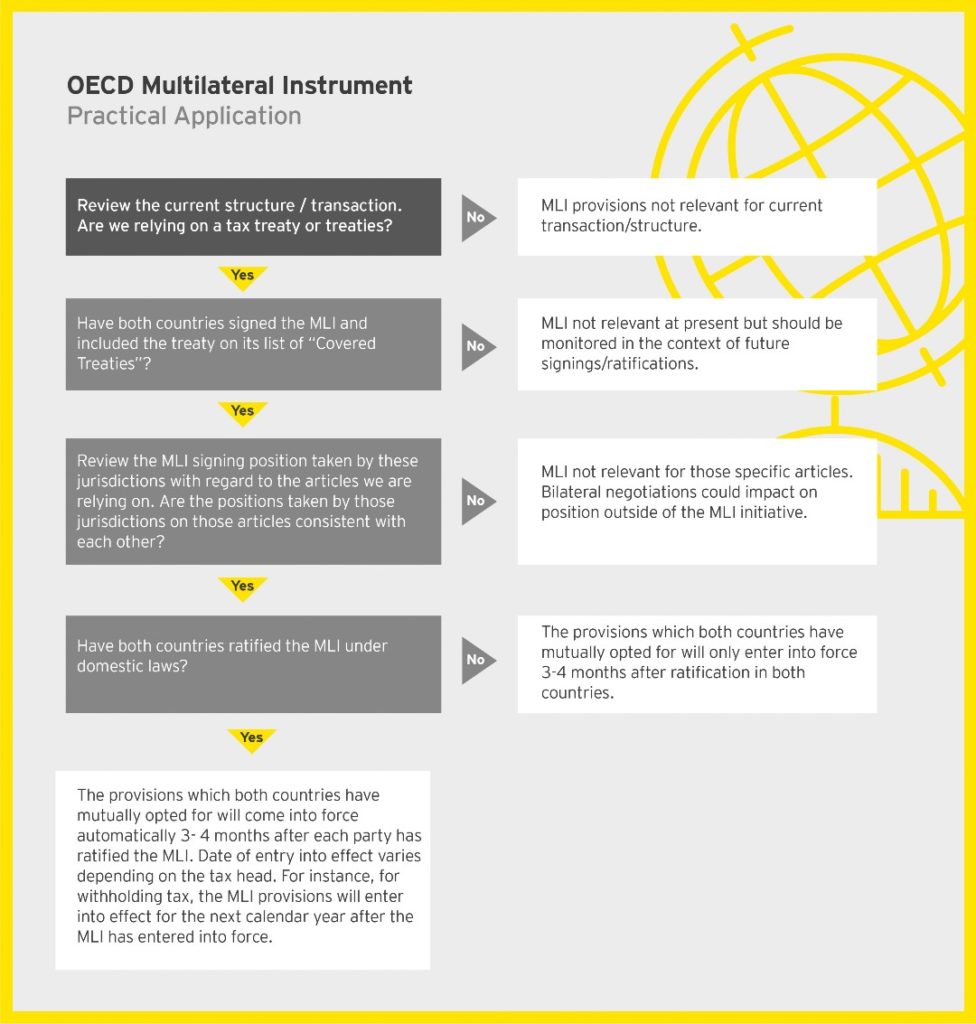The Multilateral Instrument or MLI is a far-reaching initiative in international tax and should be an important consideration for all new fund structures and in reviewing current structures.
The OECD’s Base Erosion and Profits Shifting (“BEPS”) project recommended the development of a multilateral instrument (“MLI”) to allow countries to swiftly modify their bilateral tax treaties to implement tax treaty related measures developed as part of the BEPS work.
In November 2016, the OECD formally adopted and published the agreed text of the MLI. The official signing ceremony for the MLI took place on 7 June 2017 in Paris. Its aim is to “transpose” BEPS related measures into over 2,000 treaties worldwide.
The MLI will modify tax treaties between two or more parties. It will not however, function in the same way as an amending protocol to a single existing treaty, which would directly amend the text of the tax treaty. Instead, it will be applied alongside existing tax treaties, modifying their application in order to implement the BEPS measures.
The June 2017 signing of the MLI follows a ‘speed-dating’ process whereby each country indicated its position under various Articles of the MLI. This allowed countries to get together on both a bilateral and multilateral basis to understand other countries views, thus informing each country with respect to its own position. In conjunction with the MLI signing, each jurisdiction was required to deposit a “position paper” with the OECD on the various articles of the MLI as well as a list of “covered tax treaties” or list of its own treaties which it intends will be covered by the MLI.
The MLI is specifically focused on four BEPS action points:
The MLI provides for minimum standards (with some limited exceptions) in relation to two action points: treaty abuse and dispute resolution. Where the minimum standard can be satisfied in more than one way, the parties to the treaty must endeavour to reach a mutually satisfactory solution.
There is optionality over the other two measures – hybrid mismatches and avoidance of permanent establishment. In these cases, a party to the MLI is entitled to opt out of that provision by expressing a “reservation”. This effectively means that the provision in question does not apply to any of that party’s treaties.

In the context of WAM sector, there are two action points worth considering in further detail in the context of the Multilateral Instrument- namely treaty abuse and permanent establishment avoidance.
Treaty abuse is a minimum standard under the MLI whereby all jurisdictions will be required to adopt a Principle Purpose Test but may also, in addition, chose to apply a simplified Limitation of Benefits (“LOB”) provision. Given that common holding company locations such as Ireland and Luxembourg have chosen not to implement an LOB test in their treaties, the PPT appears more likely to have a practical impact on funds structures in the medium term.
The PPT rule seeks to challenge treaty benefits where “obtaining the benefit (under a treaty) was one of the principal purposes of any arrangement or transaction” that results in that benefit. There is some uncertainty surrounding how different countries will apply the PPT. It is possible the application could be based on local General Anti Avoidance Rules (“GAAR”) in those countries.
OECD Guidance on the PPT states that obtaining the benefit under a treaty needs only be considered one of the principal purposes of the transaction in order for PPT to apply. In other words, it does not need to be the sole or dominant purpose of the transaction for the PPT provisions to apply.
Choosing Ireland as the location for regulated funds is done for many reasons including it being a recognised asset management centre, availing of EU pass-porting, significant infrastructure providing support and much more. The benefits of the tax treaty network are considered but typically this is just a by-product and in most cases is not one of the principal purposes of establishing a fund in Ireland.
With regards to Permanent Establishment Status, one of the stated aims of the MLI is to make it more difficult for a business to avoid a tax payment or filing obligation in another jurisdiction by relying on the provisions of a tax treaty.
The specific areas of concern for businesses will depend on their own business models. For example, under the MLI provisions, the activities of a local support function are more likely to trigger a PE for a fund manager; particularly in cases where it provides a local distribution function.
The MLI is also focused on tackling commissionaire arrangements (local affiliates operating as independent agents of the fund manager). Where a fund manager has more than 1 entity in a territory, the aggregate activities of all will need to be considered in considering any PE exposure.
The signing of the MLI in June did not of itself make it effective; it will need to be ratified by each country domestically. The provisions which both countries have mutually opted for will come into force automatically three to four months after both parties to the treaty have ratified the MLI. The date of “entry into effect” varies depending on the specific tax head. The flow chart below outlines how one might consider the MLI from a practical perspective in the context of a transaction or structure.
It is possible that the changes made as a result of being a party to the Multilateral Instrument would be effective in 2019, though some tax treaties may be affected as early as sometime in 2018.